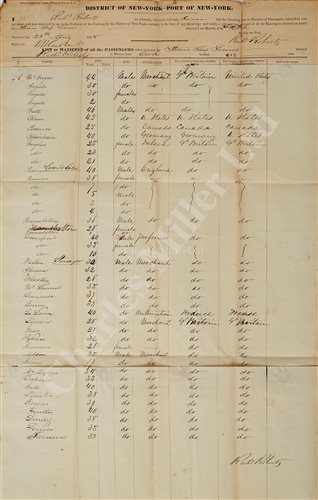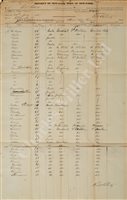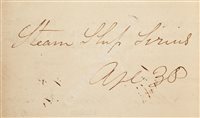2nd May, 2017 12:00
Maritime and Scientific Models, Instruments & Art ('Hibernia')
195
[M] THE NEW YORK ARRIVAL MANIFEST FOR THE S.S....
THE NEW YORK ARRIVAL MANIFEST FOR THE S.S. SIRIUS, THE FIRST STEAM SHIP TO TRAVERSE THE ATLANTIC, DATED 23RD APRIL, 1838
official printed header form completed in manuscript and attached to laid paper list annotated with the names, ages, occupations and countries of origin and residence for all crew and passengers, completed and signed three times by Captain Richard Roberts, with filing clerk's inscription to verso reading Steam Ship Sirius / Apl '38 -- 20 x 13in. (51 x 33cm.)
Despite being a small wooden paddle-steamer of no apparent significance, the humble little Sirius has assumed a notable place in maritime history as the first vessel to cross the Atlantic Ocean under sustained steam power.
Built for the St. George [later City of Cork] Steam Packet Company by Robert Menzies & Son at Leith in 1837, she was mundanely plying her trade between London and Cork when she was unexpectedly chartered by the British and American Steam Navigation Company. Their own contender for the trans-Atlantic run intended to beat Brunel's Great Western was the new British Queen but she had been delayed by the bankruptcy of her engine builder and the company was desperate for a substitute. Under the command of Lieutenant Richard Roberts, R.N., Sirius left London on 28th March 1838 and, after coaling at Cork, sailed for New York on 4th April carrying 40 passengers, 450 tons of coal and 58 casks of resin. After an eventful voyage of eighteen days and ten hours, during which not only all the coal and resin but also most of her cabin furniture, spare yards and even one of her masts had been used to keep her boilers fired up, she arrived in New York to universal acclaim as the first ship to cross the North Atlantic entirely under steam. Even though her average speed was only 6.7 knots and Great Western's was two knots faster when she docked in New York the very next day, nothing could detract from Sirius's achievement and she returned to her former duties with an enviable reputation which endured long after she herself was wrecked in Ballycotton Bay in January 1847.
official printed header form completed in manuscript and attached to laid paper list annotated with the names, ages, occupations and countries of origin and residence for all crew and passengers, completed and signed three times by Captain Richard Roberts, with filing clerk's inscription to verso reading Steam Ship Sirius / Apl '38 -- 20 x 13in. (51 x 33cm.)
Despite being a small wooden paddle-steamer of no apparent significance, the humble little Sirius has assumed a notable place in maritime history as the first vessel to cross the Atlantic Ocean under sustained steam power.
Built for the St. George [later City of Cork] Steam Packet Company by Robert Menzies & Son at Leith in 1837, she was mundanely plying her trade between London and Cork when she was unexpectedly chartered by the British and American Steam Navigation Company. Their own contender for the trans-Atlantic run intended to beat Brunel's Great Western was the new British Queen but she had been delayed by the bankruptcy of her engine builder and the company was desperate for a substitute. Under the command of Lieutenant Richard Roberts, R.N., Sirius left London on 28th March 1838 and, after coaling at Cork, sailed for New York on 4th April carrying 40 passengers, 450 tons of coal and 58 casks of resin. After an eventful voyage of eighteen days and ten hours, during which not only all the coal and resin but also most of her cabin furniture, spare yards and even one of her masts had been used to keep her boilers fired up, she arrived in New York to universal acclaim as the first ship to cross the North Atlantic entirely under steam. Even though her average speed was only 6.7 knots and Great Western's was two knots faster when she docked in New York the very next day, nothing could detract from Sirius's achievement and she returned to her former duties with an enviable reputation which endured long after she herself was wrecked in Ballycotton Bay in January 1847.
Sold for £1,736
Estimated at £1,000 - £1,500
(inc. buyer's premium of 24%)
THE NEW YORK ARRIVAL MANIFEST FOR THE S.S. SIRIUS, THE FIRST STEAM SHIP TO TRAVERSE THE ATLANTIC, DATED 23RD APRIL, 1838
official printed header form completed in manuscript and attached to laid paper list annotated with the names, ages, occupations and countries of origin and residence for all crew and passengers, completed and signed three times by Captain Richard Roberts, with filing clerk's inscription to verso reading Steam Ship Sirius / Apl '38 -- 20 x 13in. (51 x 33cm.)
Despite being a small wooden paddle-steamer of no apparent significance, the humble little Sirius has assumed a notable place in maritime history as the first vessel to cross the Atlantic Ocean under sustained steam power.
Built for the St. George [later City of Cork] Steam Packet Company by Robert Menzies & Son at Leith in 1837, she was mundanely plying her trade between London and Cork when she was unexpectedly chartered by the British and American Steam Navigation Company. Their own contender for the trans-Atlantic run intended to beat Brunel's Great Western was the new British Queen but she had been delayed by the bankruptcy of her engine builder and the company was desperate for a substitute. Under the command of Lieutenant Richard Roberts, R.N., Sirius left London on 28th March 1838 and, after coaling at Cork, sailed for New York on 4th April carrying 40 passengers, 450 tons of coal and 58 casks of resin. After an eventful voyage of eighteen days and ten hours, during which not only all the coal and resin but also most of her cabin furniture, spare yards and even one of her masts had been used to keep her boilers fired up, she arrived in New York to universal acclaim as the first ship to cross the North Atlantic entirely under steam. Even though her average speed was only 6.7 knots and Great Western's was two knots faster when she docked in New York the very next day, nothing could detract from Sirius's achievement and she returned to her former duties with an enviable reputation which endured long after she herself was wrecked in Ballycotton Bay in January 1847.
official printed header form completed in manuscript and attached to laid paper list annotated with the names, ages, occupations and countries of origin and residence for all crew and passengers, completed and signed three times by Captain Richard Roberts, with filing clerk's inscription to verso reading Steam Ship Sirius / Apl '38 -- 20 x 13in. (51 x 33cm.)
Despite being a small wooden paddle-steamer of no apparent significance, the humble little Sirius has assumed a notable place in maritime history as the first vessel to cross the Atlantic Ocean under sustained steam power.
Built for the St. George [later City of Cork] Steam Packet Company by Robert Menzies & Son at Leith in 1837, she was mundanely plying her trade between London and Cork when she was unexpectedly chartered by the British and American Steam Navigation Company. Their own contender for the trans-Atlantic run intended to beat Brunel's Great Western was the new British Queen but she had been delayed by the bankruptcy of her engine builder and the company was desperate for a substitute. Under the command of Lieutenant Richard Roberts, R.N., Sirius left London on 28th March 1838 and, after coaling at Cork, sailed for New York on 4th April carrying 40 passengers, 450 tons of coal and 58 casks of resin. After an eventful voyage of eighteen days and ten hours, during which not only all the coal and resin but also most of her cabin furniture, spare yards and even one of her masts had been used to keep her boilers fired up, she arrived in New York to universal acclaim as the first ship to cross the North Atlantic entirely under steam. Even though her average speed was only 6.7 knots and Great Western's was two knots faster when she docked in New York the very next day, nothing could detract from Sirius's achievement and she returned to her former duties with an enviable reputation which endured long after she herself was wrecked in Ballycotton Bay in January 1847.
Auction: Maritime and Scientific Models, Instruments & Art ('Hibernia'), 2nd May, 2017



